20th August 2020
The disposal of plastics is a highly visible global problem – from the highest mountains to the deepest ocean trenches, waste plastic seems inescapable. In natural conditions, plastics are nearly indestructible, and yet they are discarded worldwide on a large scale: the world produces around 359 million tonnes of plastics each year. The environment cannot address their disposal at a speed fast enough to prevent harm to living beings.
This has led to a consensus that plastics are an unsustainable material. And yes, plastics are certainly an enormous problem, but they don’t necessarily have to be.
The main issue is not with plastic as a material, but with our linear economic model: goods are produced, consumed, then disposed of. This model assumes endless economic growth and doesn’t consider the planet’s exhaustible resources.
But there are many ways we could set plastics on a different lifecycle – and one that I have been working on is turning disused plastics into a hardy, reliable and sustainable building material.
You might also like:
- The country building a ‘new London’ every year
- The winding maze that cleans Hong Kong
- Can we heat buildings without burning fossil fuels?
Most people believe that plastics recycling is severely restricted: that only a few types can be recycled at all. This is unsurprising. The proportion of plastics that are recycled is minimal. The UK, for example, uses five million tonnes of plastic each year, and only 370,000 tonnes are recycled each year: that’s just 7%.
Plastics are strong, durable, waterproof, lightweight, easy to mould, and recyclable – all key properties for construction materials
But all polymers are, technologically, 100% recyclable. Some of them have the perfect cradle-to-cradle lifecycle: they can be used again and again to produce the same goods. Some plastics can be reused just as they are by shredding an object into flakes, melting it, and reusing.

Bricks like these could be the prototype for plastic bricks that are strong and durable enough to be used in construction (Credit: Sibele Cestari)
Such recycled plastics may have lower mechanical properties compared to virgin plastics, because each time you melt and process a plastic, the polymeric chains degrade. But these properties can be recovered by mixing it to additives or virgin plastic. Examples of successful industrial recycling include PET, or poly(ethylene therephtalate), which is used to make soft drinks bottles, and polystyrene.
All of the rest can technically be reprocessed into new materials for different applications. In the final instance, any plastic waste can be shredded and used as filler for asphalt, or be pyrolysed – decomposed through heating – to produce fuel. The Japanese company Blest Corporation already sells a portable machine to convert domestic plastic waste into fuel in a simple, affordable way.
Working with the ‘unrecyclable’ waste and developing plastics alternatives to natural materials may reduce demand on the world’s resources
The problem is that recycling much of this plastic waste is currently unfeasible and unprofitable. Polymers such as rubbers, elastomers, thermosets and mixed plastic waste are comfortably labelled as “unrecyclable” by the recycling sector. But the amount of these materials all over the world is frighteningly large and keeps on growing. What if this plastic waste could be used to produce something useful to society?
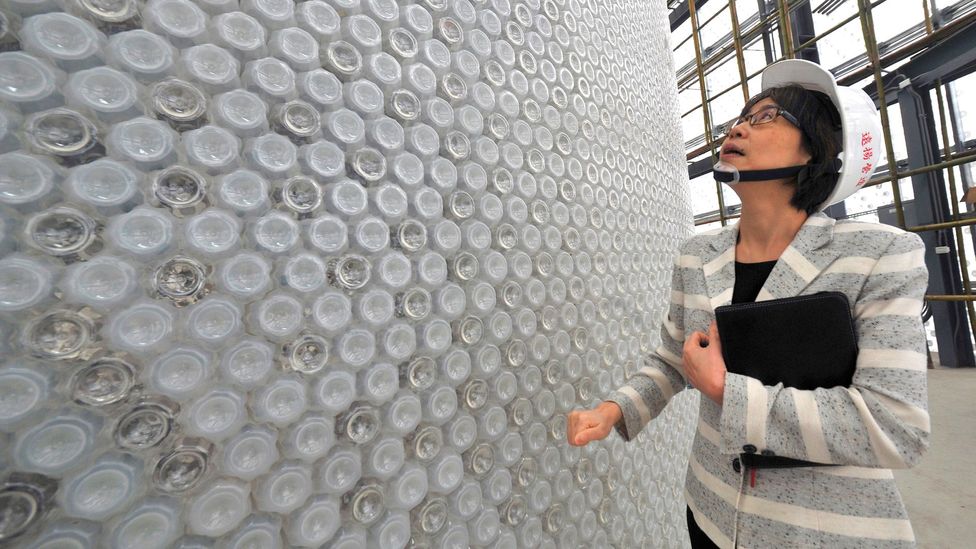
Plastic items we think of as rubbish can have a second life in construction due to the same properties that make them so hard to dispose of (Credit: Getty Images)
Many universities and entrepreneurs are attempting to do this. Most solutions target mixed plastic waste and suggest applications different from the original ones. For example, several groups have developed building materials made of plastic waste.
Plastics are strong, durable, waterproof, lightweight, easy to mould, and recyclable – all key properties for construction materials. So what if all of this plastic waste could be converted into building materials for low-income populations? Existing initiatives are promising, but not yet reproducible on an industrial scale.
I study plastic waste with the specific aim of finding interesting ways to remove it from the environment. Since 2009, I have developed a number of building materials made of post-consumer plastics mixed with different waste-stream materials. From agricultural wastes such as sugarcane bagasse – a by-product of the sugar industry in Brazil – and coffee dregs, to concrete waste and construction debris, compounded with recycled plastics, there are many ways to obtain materials to produce bricks, roof tiles, plastic lumber and other useful elements for building.
Our team is currently trying to develop a viable building block made of recycled plastics. We have prepared a range of prospective materials using a mix of virgin and recycled plastics – coloured PET bottles, polypropylene, polyethylene – and other local waste-stream materials, such as hemp, sawdust, concrete waste and red mud.

There is a common conception that some plastic is "unrecyclable", but given the right treatment it need not go to landfill (Credit: Sibele Cestari)
We are currently adjusting the properties of the materials for the rotomoulding process, a plastics moulding technology that is ideal for making large hollow articles. We want to use the maximum amount of recycled plastics in this block. Blocks made of 25% recycled plastics have performed extremely well in mechanical tests. Next we’ll try 50%, 75% and 100%.
We are also thinking about the aesthetics of the blocks. Blends of recycled mixed-colour plastics usually end up with a grey or black colour. To enable colour, we are preparing blends of virgin or recycled plastics to overlay the main bulk of the block.
So perhaps plastics are not necessarily the problem. They can be part of a pathway towards a more sustainable way of living. Using a natural or renewable resource is not necessarily environmentally friendly. The ecological footprint of a polymeric material is smaller than that of natural materials, which have a sizeable demand on arable land, clean water, fertilisers and regeneration time.
According to the Global Footprint Network, before the pandemic we were demanding 1.75 times the available resources of the planet. Working with the “unrecyclable” waste and developing plastics alternatives to natural materials may reduce this demand and leave a cleaner and more sustainable planet for the next generations.

Building with plastic waste requires fewer resources than natural products, and would otherwise go to landfill or into the oceans (Credit: Sibele Cestari)
Building materials made from recycled plastics are not yet widely used in the construction industry – prototypes have mainly been used for demonstrative installations. It will take political will and widespread environmental awareness to encourage more investment into the potential in plastics recycling.
But hopefully the tide is beginning to turn, as a consequence of the increasing pressure from public opinion about the plastic pollution matter. Thanks to the engagement of government and industry with the idea of a circular economy, it seems that there will be an opening in the market – and in people’s minds – to welcome plastic initiatives to replace conventional building materials.
--
Sibele Cestari is a research fellow in polymeric materials at Queen's University Belfast. This article originally appeared on The Conversation, and is republished under a Creative Commons licence. This is also why this story does not have an estimate for its carbon emissions, as Future Planet stories usually do.
--
Join one million Future fans by liking us on Facebook, or follow us on Twitter or Instagram.
If you liked this story, sign up for the weekly bbc.com features newsletter, called “The Essential List”. A handpicked selection of stories from BBC Future, Culture, Worklife, and Travel, delivered to your inbox every Friday.

Otters do not usually fly. But if sea otter elders in Checleset Bay told floating bedtime stories to modern day pups, they might tell of their ancestors’ bizarre flying adventure.
Beginning in 1969, sea otters from Amchitka and Prince William Sound in Alaska were packed onto planes and flown on a long journey south. Canadian and US biologists had a plan – one they didn’t discuss with First Nations. Sea otter biologists hoped these otters would start a new colony in the forest-fringed waters of Checleset Bay, British Columbia. Otters were not entirely new on this section of windswept Pacific coast, but prior to these transplants the last sea otter seen in Checleset Bay was in 1929, just before it was shot.
It wasn’t just this remote British Columbian bay where sea otters disappeared. Prized for their luxurious warm pelts, sea otters along vast stretches of the north Pacific Rim were decimated by the European fur trade of the 18th and 19th centuries. Historic population sizes, like the otters themselves, are fuzzy. But global estimates suggest sea otters numbered 150,000-300,000 in the early 1700s. By 1911, when an international treaty afforded the creatures some protection, they had shrunk to around 2,000. Now, the original Alaskan otters released into British Columbia waters have grown from a population of 89 to more than 7,000.
In fact, the reintroduction of these early romps of otters has arguably been too successful, bringing a number of unintended consequences for British Columbia’s coastal First Nations.
Tipping the balance
As otter populations have grown – first slowly, now apace – other species they feed upon have been driven to scarcity, including the crabs, clams, abalone and shellfish that coastal First Nations communities formerly relied on. Rebounding otters are now so abundant that on some sections of British Columbian coast they are exhausting their own food supplies. That food squeeze lowers the survival of pups, driving pioneering males to seek food elsewhere. Females track behind causing the sea otter population to spread out and recolonise available habitat, explains Jenn Burt, a marine ecologist at Simon Fraser University who has been studying sea otters alongside First Nations collaborators.
You might also like:
- How can we deal with medical waste?
- The world’s growing concrete coasts
- The ingenious ‘solar canals’ of India
Otter pressure is being felt most keenly by the Kyuquot/Checkleset First Nations who live at the epicentre of otter abundance: the site of their initial reintroduction. Before the otters returned, clams of many sizes and species were abundant on local beaches, recalls Saqᵂistl Hilda Hanson, an Elder of the Kyuquot/Checkleset Nation. “It was the best clam beach that ever was,” she said at a research workshop in 2018. Now that sea otters have returned, the clam cupboard is bare.
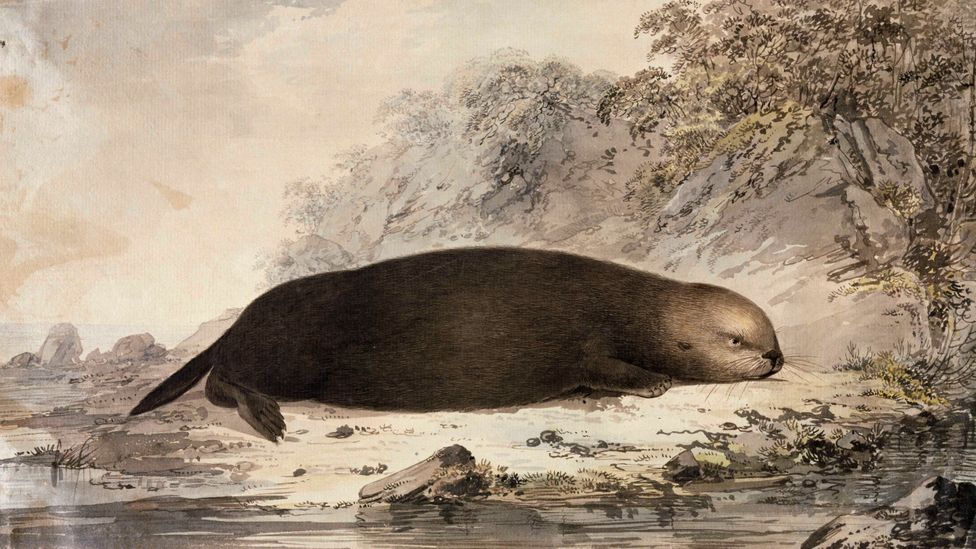
The fur trade of the 17th and 18th centuries destroyed otter populations in parts of Canada, so to revive them otters were flown in from elsewhere (Credit: Getty Images)
Such traditional knowledge is supported by scientific data. Within one year of otter arrival at previously unoccupied sites on the Central Coast of British Columbia, territory of the Heiltsuk and Wuikinuxv First Nations, numbers of large sea urchins plummeted, a trend also seen from surveys on the west coast of Vancouver Island. Otter return has seen abalone numbers crash too, at some sites declining 16-fold, with similar trends for sea cucumbers in Alaska.
There’s something most sea otter research has neglected: their coexistence with the humans that, pre-fur-trade, shared their habitat for thousands of years
For coastal First Nations in remote places like Kyuquot – at least five hours travelling time by dirt road, highway and boat from the nearest town – this has a huge impact. For these remote communities, “the supply of local shellfish is the grocery store – and has been forever”, says Burt. The loss of clams, sea urchins, crabs and other edible species easily harvested from the beaches year-round is felt acutely. It contributes, she says, to “a huge shift in food security and health”.
Diving deep
Plenty is known about sea otter ecology. Iconic sleek swimmers, they bob on the waves by floating on their backs like humans lolling in a pool. One of the few marine mammals to use tools, sea otters pry loose and crack open hard-shelled prey like mussels using rocks like hammers and chisels underwater and on their bellies. These predators often feature in ecology students’ first lessons about keystone species and the waterfall of effects triggered by their extinction from communities – knowledge that emerged only after British Columbia’s otter reintroductions, and something scientists call an ecological cascade. But though sea otters have been the darlings of many a scientific study, there’s something most sea otter research has neglected: their coexistence with the humans that, pre-fur-trade, shared their habitat for thousands of years.
This is an imbalance that First Nations knowledge holders and Elders, and a team of scientists led by Burt during her doctoral studies, are seeking to redress. To navigate the profound ecological shift from too few to what some argue is too many otters, their research took a human-centred look at solutions for smoothing the waters. To do that, they first had to understand the long history of otters on the British Columbian coast, and these mercurial animals’ relationship with humans.
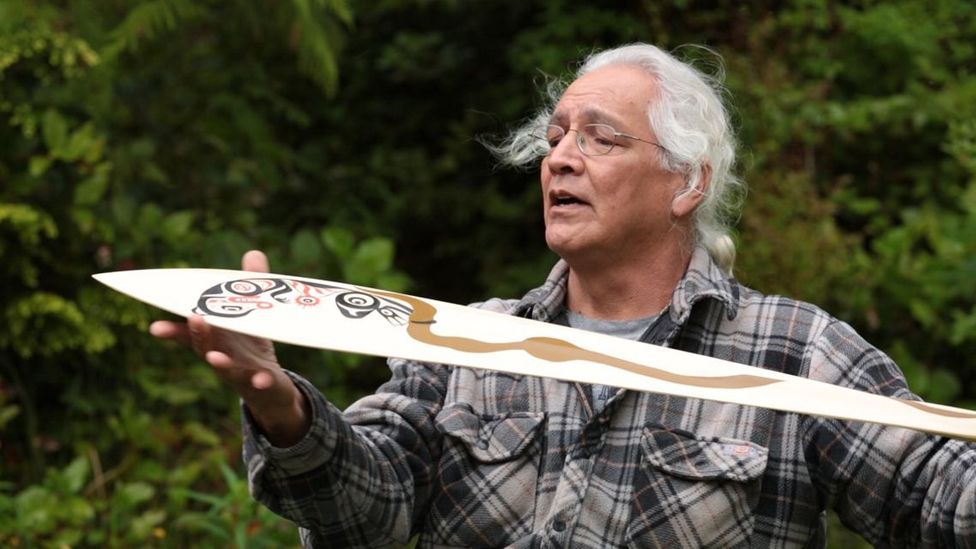
First Nations of British Columbia's coast have a long history that is intertwined with that of sea otters in the area (Credit: Ilja Herb)
Otters are voracious shellfish eaters. And for at least 10,000 years, long before colonisation, British Columbia’s coastal First Nations harvested shellfish and managed otter populations too. University of Victoria archaeologist Iain McKechnie and his collaborators have gleaned evidence supporting this linked history from ancient coastal settlement sites. Looking within middens – ancient rubbish heaps – at the quantities of sea otter bones relative to those of other animals harvested by First Nations, they examined trends over time to estimate the abundance of otters. Geochemical information from the otter bones, with clues from stable isotopes of carbon and nitrogen, revealed the otters’ diets of the distant past. Chemical analysis revealed consistent diets over 5,000-plus years. That, suggests McKechnie, means otters were well fed and eating the things they liked to eat for centuries, until the fur trade upset the balance.
In pre-colonial times, McKechnie’s work suggests, otters in coastal British Columbia never reached such high densities that competition drove them to look for new things to eat, like fish. That contrasts with what is happening with some modern-day otters, like those in California’s Monterey Bay and the Aleutian Islands in Alaska. A consistent diet over time, says McKechnie, suggests that people coexisting with otters “were actively hunting and managing their landscapes”.
Before European colonisation of the British Columbia coast, Burt’s research collaborator Wii-tsts-koom Anne Mack, Hereditary and elected Chief of Toquaht Nation, explains that for the Nuu-chah-nulth First Nation, otter fur robes were a status symbol. “That’s how they would distinguish the chiefs,” Mack says. For the Haida, another Pacific coastal First Nation, head chiefs wore and lined beds with otter fur too, says Haida matriarch and scholar Kii’iljuus Barb Wilson. Long before the fur trade accelerated and led to some 99% of the animals being wiped out, sea otters were a culturally and economically important resource.
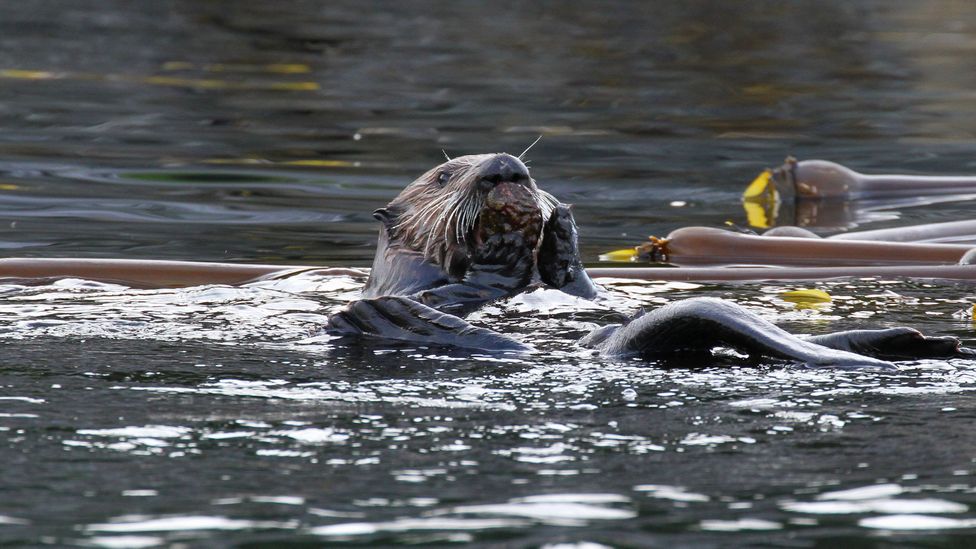
A revival of sea otters in British Columbia might be welcomed by some, but their burgeoning numbers are threatening the species they feed on, such as abalone (Credit: Stef Olcen)
First Nations developed multiple ways of managing sea otters, their co-competitors for shellfish. Beyond hunting otters for pelts in boats with paddles specially designed to quietly slip through kelp, they also defended the shoreline. It was the job of one family to dissuade hungry otters that attempted to rob shellfish, says Hup In Yook Tom Happynook, Huu-ay-aht Hereditary Whaling Chief of the Nuu-chah-nulth Nation. “My grandfather used to say that to deter the sea otters from coming onto the beach, they would kill a couple of them and anchor them… so that the sea otters that were coming in would see their cousins had been killed,” says Happynook.
“Prior to colonialism being put upon us through the Fisheries Act and the Indian Act, our Hereditary Leaders had control over specific territories,” says Wilson. Controlling the area came with the responsibility for looking after everything in the territory. “That included the people, because people are very much a part of what is the ecosystem,” she says.
Clam gardens – watery raised beds along the coast that created sheltered waters for shellfish cultivation – also had stone walls perhaps just high enough to impede otters climbing in for a feast. Department and Fisheries and Oceans (DFO) sea otter biologist Linda Nichol explains that while a river otter “can scoot around on the land quite well”, the hind paws of sea otters have “elongated to create flippers so they are quite awkward on land”. Nichol grew up around the Strait of Georgia, the protected narrow stretch of Pacific between Vancouver and Vancouver Island. She was a young child when sea otters were reintroduced to Checleset Bay.
Checleset Bay otter numbers didn’t immediately take off. At first they struggled to adapt. By 1977, the original 89 had dipped down to 70. Somehow, just as sleeping otters cling to kelp, their population hung on and then began to grow. Similar translocations of Alaskan otters to the Washington and Oregon coast were not as successful. Colonies of otters in Oregon eventually blinked out, with sea otters in that state now found only in aquaria.

Research projects on sea otters with First Nations collaborators could lead to a fairer and more sustainable approach to managing otter numbers along the coast (Credit: Ilja Herb)
On the island shores of Haida Gwaii , some 300km north-west of Checleset Bay, otters have been absent for a century but in recent years there have been periodic sightings of solitary otter males cruising by. With local reliance on shellfish, there is strong motivation to seek sea otter management solutions before more arrive along with their voracious appetites.
As Burt’s collaborative study notes, First Nations were never consulted prior to British Columbia’s Checleset Bay sea otter reintroductions. “In that era there was a real recognition of major declines in species… and an overarching desire, where possible, to turn those things around,” says Nichol, who joined DFO in 2001 as part of a group monitoring otter recovery. Acknowledging the reintroduction era as one of disconnection with indigenous people, at that time, “a full grasp of the ecosystem shift that results from sea otters was also not yet well recognised”, she says.
Smoothing the waters
This story of sea otter conservation is part of a legacy of colonial-style conservation, says Anne Salomon, a socio-ecological systems researcher at Simon Fraser University, and originator of a broader Coastal Voices multimedia project, working with Burt and multiple First Nations. Protecting nature from people by treating humans and nature as separate rather than integrated, she elaborates, prioritises the well-being of an endangered species at the cost of impoverishing indigenous people who coexisted successfully with otters for millennia before Europeans arrived, historically managing numbers so that they, like the otters, could benefit from the shellfish bounty of the shores.
Through Salomon and Burt’s research collaboration, combining indigenous knowledge and Western science, they are aiming to chart a middle ground, broadening the conversation surrounding sea otter recovery, says Salomon, “to one that focuses on social-ecological resilience and boldly addresses issues of equity, justice, and inclusivity”.
To launch their more recent examination of otter-human interactions in British Columbia, Salomon and Wilson, her early partner on the project, wanted to gain the blessing of Hereditary Chief Councils of the Nuu-chah-nulth, Haida and Heiltsuk First Nations. Arriving in the massive room to present their research idea for review by assembled First Nation leaders, Salomon remembers feeling intimidated by the responsibility of forging positive relationships across cultures, the success of the project hanging in the balance. Wilson recalls turning to her to whisper “I’m so scared,” and Salomon whispering back “at least you’re First Nations!”
The Hereditary Chiefs did give their blessing for the research to proceed. That affirmation led to the group’s 2014 workshop bringing together archaeologists, scientists, leaders and representatives from 19 First Nations across British Columbia and Alaska to discuss otter, shellfish, kelp and humans interactions and brainstorm coexistence solutions. Discussing the past, present and future, the researchers then surveyed attitudes and ideas of adults aged 19-96 in one Alaskan and one British Columbian community, places with contrasting timelines of rebounding otter coexistence.
First Nations are essentially in a never-ending battle of trying to assert their indigenous rights to manage resources – Jenn Burt
The people of the Kyuquot/Chekleset First Nations, living where biologists had introduced otters in the 1970s, had the least favourable view of the otters. “I feel like sea otters have more rights than I do,” says Skil Hiilans Allan Davidson, Hereditary Chief of the Haida Nation, one of Burt and Salomon’s coauthors. But in the Sugpiaq villages of Port Graham and Nanwalek, attitudes towards sea otters, which re-established there naturally in the 1950s, were more neutral or even positive.
Though attitudes differed depending upon time since otter arrival, solutions suggested for improved coexistence converged on a desire for valuing indigenous knowledge, increasing indigenous authority and governance, and shared learning between indigenous communities around resource decision-making.
The Sugpiaq people already hunt limited numbers of sea otters under a waiver to the US Marine Mammal Protection Act (1972) permitting hunting for processing and fashioning into handicrafts. But in Canada, despite otters reaching an abundance where the Species at Risk Act technically permits a First Nations licence to hunt otters for food, social or ceremonial purposes, a tense relationship between Canada’s Federal Department of Fisheries and Oceans and coastal First Nations has thus far not led to sanctioned sea otter hunting. That, this new research argues, needs to change, with First Nations rights to non-wasteful sea otter hunting part of new path forward.
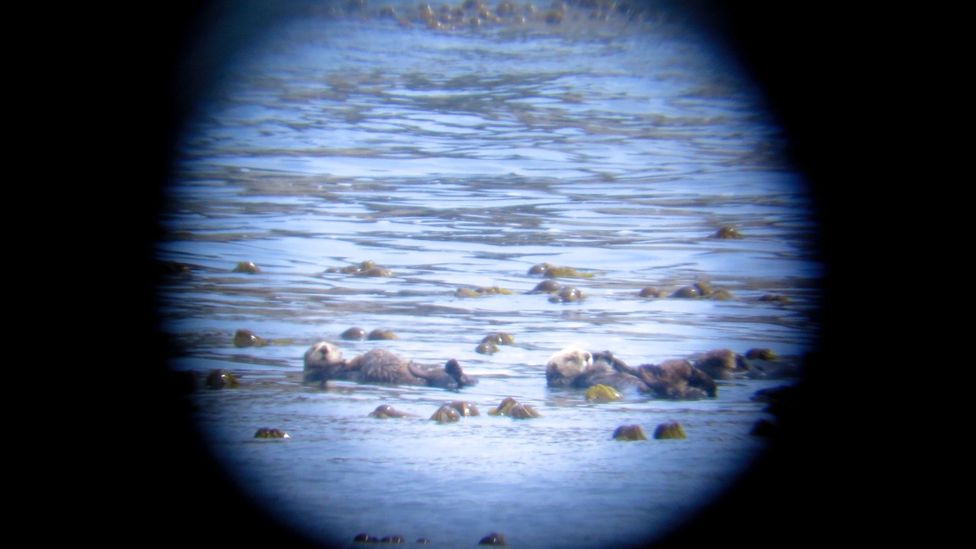
The tenacity of the sea otter over centuries is thought to be down to its diversity of prey and ability to learn (Credit: Jenn Burt)
“First Nations are essentially in a never-ending battle of trying to assert their indigenous rights to manage resources,” says Burt. Though British Columbia was the first Canadian province to sign the United Nations Declaration on the Rights of Indigenous Peoples (UNDRIP) into law in 2019, it has yet to be endorsed at a national level.
“Each time we want to have one of the things we did pre-history… we have to go to court, and it’s dragged on for decades,” says Wilson. Canada has enacted blanket laws like the Fisheries Act and Indian Act that generically undermines rights of indigenous peoples to resource sovereignty on traditional territories. Yet in regaining the recognition of resource rights and sovereignty, “each nation has to go separately”, says Wilson. “It’s like having a bully at school.”
Swimming forward
Though a return to their once widespread global distribution is still not secured, in its ability to come back, the sea otter is a remarkable story of resilience, says Angela Doroff, scientist with the International Union for Conservation of Nature’s sea otter specialist group. Sea otters have some special traits that have made a comeback possible. These, she says, include “its diversity of prey, its ability to learn and share learning”.
Shared learning, it appears, benefits otters and humans alike. From the beginning of the project, “we have all been willing to learn from each other and trust each other,” says Salomon. That positive relationship fostered between First Nations and Western scientists around study design, focus, and implementation, “is not typically done in science or resource management,” argues Salomon. “It ought to be. It needs to be,” she says.
Towards more harmonious sea otter-First Nations coexistence, Wilson sees collaborations between scientists and indigenous communities as “the kind of outside the box [solutions] that we have to do”.
From a purely species-driven ecological perspective, the sea otter boom along the British Columbian coast might seem like a simple success story. Otters were locally extinct. Now they are thriving and recolonising. But setting aside that narrow, colonialist conservation lens, a more complex picture emerges. The story of rebounding otters, notes Burt, “is a narrative where the costs and benefits differ depending on what perspective you come from”.
With First Nations increasingly leading research efforts, the next chapter of the story could benefit from a new view: that the humans that have lived alongside otters for millennia are an important thread not separate from, but woven into the rich fabric of Pacific coast ecosystems.
--
The emissions from travel it took to report this story were 0kg CO2. The digital emissions from this story are an estimated 1.2g to 3.6g CO2 per page view. Find out more about how we calculated this figure here.
--
Join one million Future fans by liking us on Facebook, or follow us on Twitter or Instagram.
If you liked this story, sign up for the weekly bbc.com features newsletter, called “The Essential List”. A handpicked selection of stories from BBC Future, Culture, Worklife, and Travel, delivered to your inbox every Friday.
--
Lesley Evans Ogden is @ljevanso on Twitter.
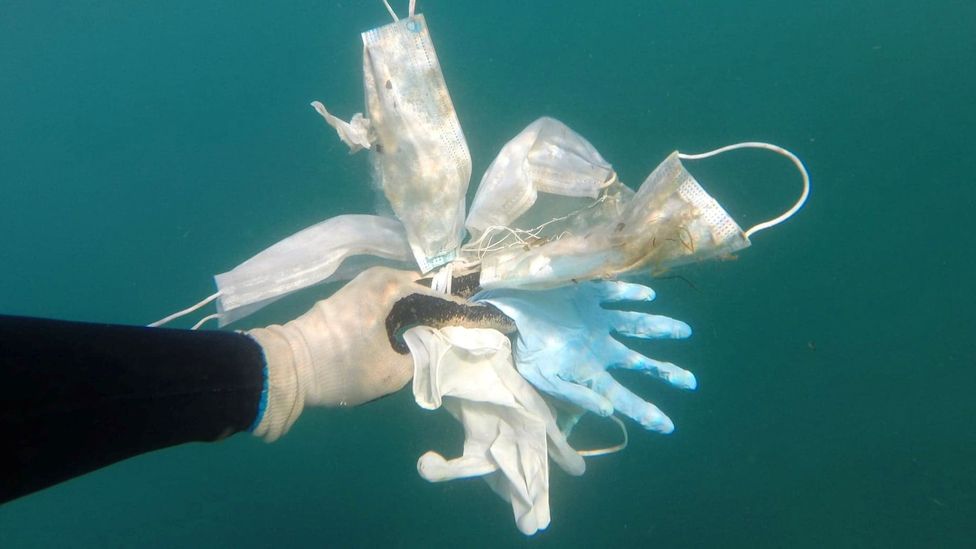
When surgeon Claire Teves* (not her real name) landed in Singapore from the Philippines for a six-month fellowship, she knew it would take some time to adjust. Teves had come from a hospital serving the needs of a poorer developing society, to work in a cutting-edge medical facility in a much wealthier one. She was braced to overcome a knowledge gap at this world-class facility, and face different day-to-day medical challenges. But when she arrived, she faced a very different culture shock: how the new hospital used plastics.
In the operating theatre, devices such as plastic retractors – which are used to hold surgical cuts open – were used once per patient and then thrown away at the end of the procedure to be disposed of as medical waste. In her hospital in the Philippines, the same device would be painstakingly sterilised and reused until it was worn out and beyond repair.
Seeing these life-saving items being thrown away when they were so sought-after in the Philippines, Teves decided to do something about it. “When I saw the waste, I thought to save whatever single-use equipment I could get my hands on, so I could recycle them and bring them back,” she says. It was a decision that would have ruffled some feathers at the Singapore hospital if it wasn’t carried out with discretion and the help of friendly staff. In the end she managed to fill a large suitcase with “single use” plastic surgical devices that would otherwise have gone to waste.
You might also like:
- The ingenious ‘solar canals’ of India
- The world’s growing concrete coasts
- The wells bringing hope in the desert
Addressing the environmental impact of healthcare, from plastics to fossil fuel reliance, can quickly become a charged debate. After all, when it comes to saving lives, the patient in front of a doctor is always the first concern. “It’s very good in theory to talk about healthcare and its environmental footprint, which is not insignificant,” says Hong Kong-based cardiologist Ryan Ko. “But it’s another thing altogether when you’re on the front lines of healthcare. As doctors, we are required to make patients’ immediate needs and requirements a priority, and that needs to come first.”
Fossil fuel combustion is a major contributor to air pollution-related deaths, which kill more than four million people around the world every year – Gary Cohen
Even Teves agrees – her motivation in saving devices was to provide equipment for patients in the Philippines. “Addressing sustainability is not really on our priority list; everything we do is about helping our patients,” she says.

Air pollution kills more than four times the number of people who die from Aids, malaria and tuberculosis combined (Credit: EPA)
Others point out that in the broader sense, sustainability is also about helping patients – or rather, preventing people having to go to hospital in the first place.
Take the healthcare industry’s carbon emissions – if healthcare were a country, it would be the fifth-largest emitter of greenhouse gases on the planet, according to the non-profit organisation Health Care Without Harm. That’s a carbon footprint the same as the emissions of 514 coal-fired power plants, equivalent to 4.4% of global net emissions. More than half of that was a result of energy use: electricity, gas, steam, air conditioning and operational emissions.
“Fossil fuel combustion is a major contributor to air pollution-related deaths, which kill more than four million people around the world every year. More than tuberculosis, more than malaria, and more than Aids combined,” says Gary Cohen, president and co-founder of Health Care Without Harm.
Cost of waste
One of the problems is those on the frontline often see providing necessary healthcare and being environmentally friendly as an either/or choice. “It’s difficult to think about sustainability when we have to weigh that up against the safety of a patient,” says Ko.
In people’s minds now, both single-use protective equipment and single-use medical equipment are understood as safer. But that is not necessarily true – Tony Capon
But what if doctors worked in a healthcare system where they didn’t have to make a choice between the two?
Sometimes the shift is as simple as challenging assumptions. Take single-use plastics; healthcare workers on the front line emphasise that there is a legitimate need for single-use plastics, primarily to prevent infectious diseases from taking hold and spreading – and Covid-19 is a perfect example of this need. While no one would argue that safely disposing of hazardous used PPE is essential when it comes to infectious diseases like Covid-19, only 15% of healthcare waste is actually classed as “hazardous” – which covers waste that could be a source of infection, or is radioactive or toxic.
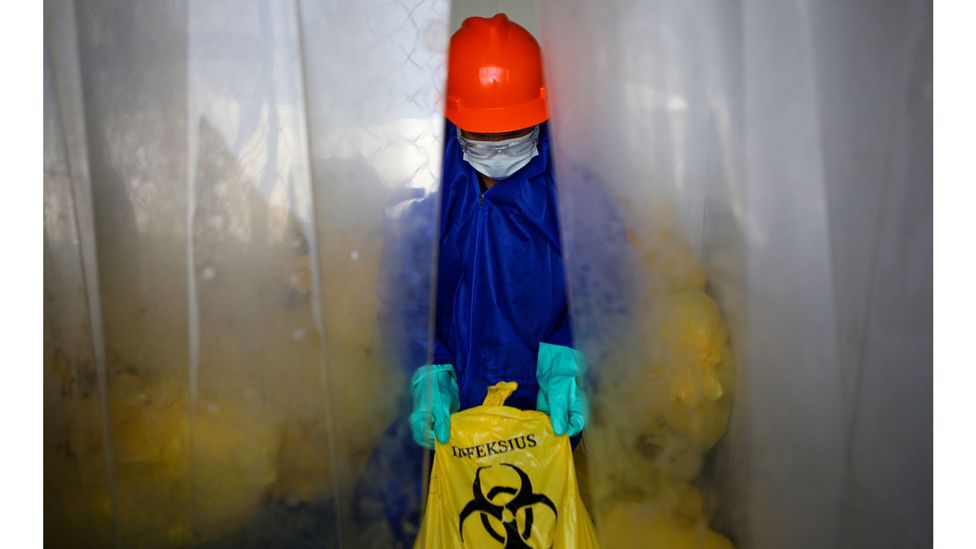
Only 15% of medical waste is classed as hazardous - but the rest is little more dangerous than household waste (Credit: Reuters)
The other 85% of medical waste is not much different from the waste we generate at home, or at work. This waste might cover used food containers, packaging materials or gloves worn to inspect a non-infectious patient. It’s this non-hazardous 85% where the reductions could come.
“In people’s minds now, both single-use protective equipment and single-use medical equipment are understood as safer. But that is not necessarily true,” says Tony Capon, director of the Monash Sustainable Development Institute. “When I was beginning my medical career, it was standard practice for things to be cleaned and autoclaved. Medical equipment was routinely cleaned up, sterilised and reused.”
Coronavirus could well become a catalyst, because people may realise that by degrading our environment, we could find that we are getting more and more of these types of diseases – Sonia Roschnik
Then there is the question of cost. Single-use disposables are perceived to cost less upfront, than supplies which need to be maintained carefully to prevent infection and early wear and tear. But in the longer term, there is a high cost to constantly replacing devices. Neurosurgeons at one Canadian hospital, for example, cut their costs by CA$750,000 ($570,000/£430,000) by reducing use of disposables by 30%.
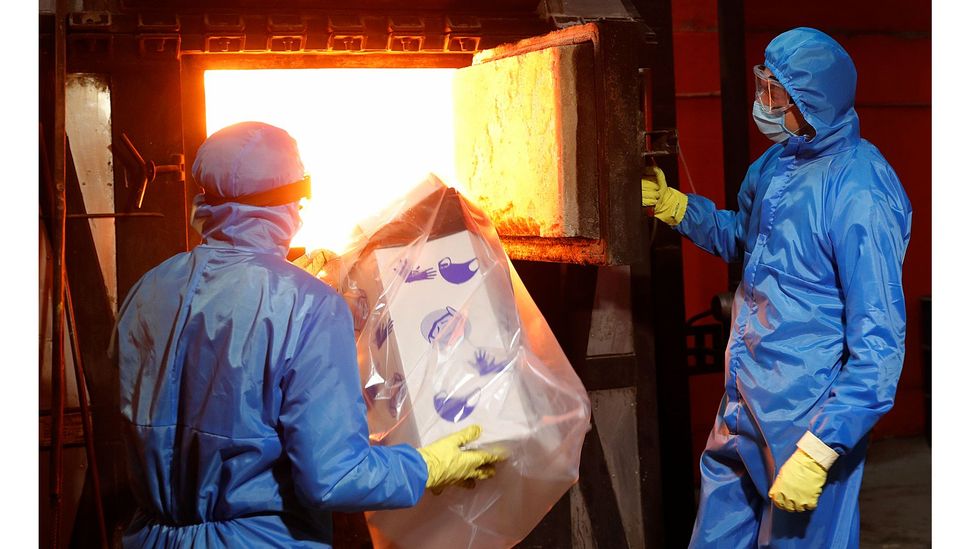
Saving reusable "waste" from the incinerator can cut hospital costs, leaving more money to channel into caring for patients (Credit: Reuters)
Plastic gloves are a good example. Sonia Roschnik, the former director of the Sustainable Development Unit for England’s National Health Service, recalls a time when nurses at London’s Great Ormond Street hospital realised that healthcare professionals were choosing to use non-surgical gloves instead of washing their hands, when performing tasks such as moving beds or bathing babies. When nurses started to remind staff that the gloves weren’t intended for these purposes, glove usage went down, says Roschnik. The hospital was able to cut its use of plastic gloves, saving 21 tonnes of plastic and £90,000 ($120,000) as a result.
Roschnik, who is now international climate policy director at Health Care Without Harm, adds that the industry “could also go some way into cleaning up if it reutilises certain items, and if there is a concerted effort to segregate waste more efficiently, because not all of the rubbish needs to go into a high-infectious work stream”.
There is certainly a way to go. In 2018, a survey conducted across four Mayo Clinic locations across the United States found that single-use plastics made up at least 20% of medical waste generated in US hospitals; 57% of those surveyed didn’t know which items in operating theatres could be recycled, 39% said they either sometimes or never recycled, and that 48% had “a lack of knowledge” about recycling.
The widespread lack of an efficient medical recycling system represents a part of the bigger problem with the industry as a whole. In a commentary on healthcare’s role in the global climate crisis, Yale School of Medicine associate professor of anaesthesiology Jodi Sherman called environmental sustainability an “unappreciated dimension of health quality care”. She and her co-authors also pointed out that traditional assessments in the successes or failures in the healthcare system as a whole have yet to factor in the cost of pollution both up and downstream of the industry’s supply chain, from resource extraction to disposal management.
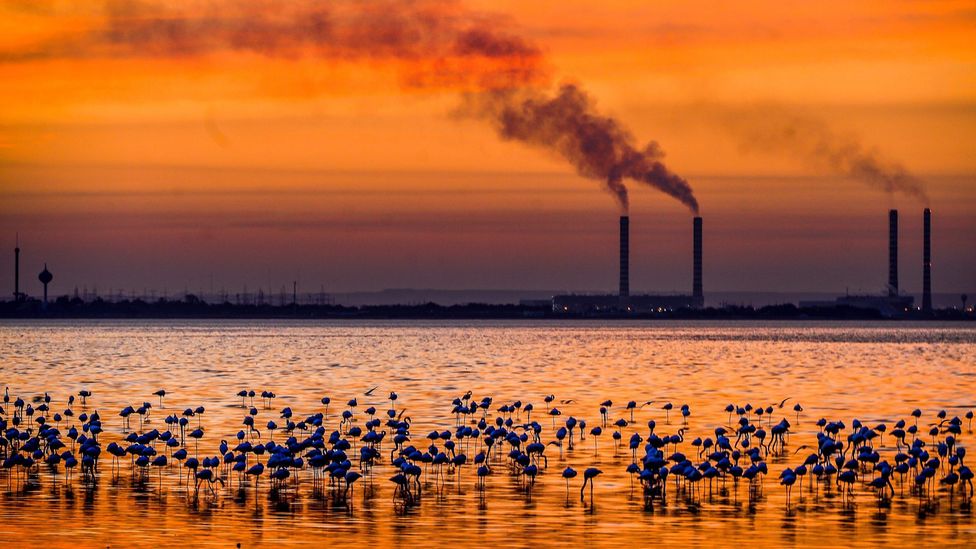
Rather than relying on fossil fuel combustion for energy, some hospitals are sourcing renewable energy to cut emissions and save money (Credit: EPA)
With medical waste currently more visible than ever, researchers are calling for healthcare’s waste and environmental footprint to be brought up the agenda. “Coronavirus could well become a catalyst, because people may realise that by degrading our environment, we could find that we are getting more and more of these types of diseases,” says Roschnik. “Do we as a people want to live this way? Or do we say: if we want to be healthy, our planet needs to be healthy – and it’s incumbent on all of us to do something about it.”
Climate health
Cutting greenhouse gas emissions is perhaps the most direct way that healthcare facilities can align pro-environmental behaviour and human health benefits. Aside from the disease and deaths caused worldwide by increased extreme weather, heatwaves and sea level rise, cutting emissions often comes with cost savings that can be channelled back into healthcare.
In the US, Boston Medical Center, for example, is using solar energy to meet its energy needs by buying its electricity from solar farms, saving $25m (£19m) as a result. The Cleveland Clinic, which invested in 15 internationally certified energy-efficient buildings, saw its energy consumption decrease by 19% as a result, which translates into $50m in (£38m) savings. Energy efficiency measures also slashed consumption at Canada’s McGill University Health Centre, which resulted in savings of up to C$2m ($1.5m; £1.1m) a year, and the hospital’s electronic waste recycling program processed 52 tonnes of electronic devices over the span of a decade.
Other hospitals are looking into their food supply chain as a way of making their operations more carbon friendly. The University of Washington Medical Center has begun using a more sustainable, efficient food procurement system to improve its carbon footprint, by working with a local farmers union to provide locally grown, organic food to both patients and paying customers. The University of California, San Diego Health eliminates food waste either through composting or donating uneaten meals; their goal is to cut their food-related emissions by 25% by 2030.
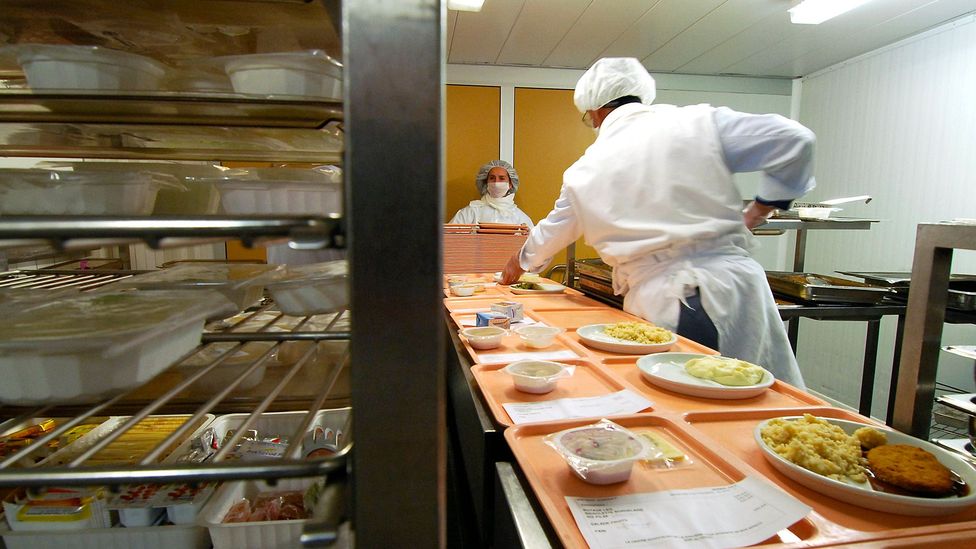
Food is a significant source of carbon emissions, and some hospitals are reducing this impact through working with local suppliers (Credit: SPL)
Besides carbon dioxide, healthcare relies on several more potent greenhouse gases; operating theatres rely on the anaesthetic gases desflurane, sevoflurane and nitrous oxide, which are greenhouse gases. Only 5% of these gases actually enter a patient’s system during surgery – the rest is vented out as medical waste. These halogenated gases have the global warming potential up to 2,000 times greater than carbon dioxide. Researchers have suggested reducing emissions by using gas-capture technology that uses canisters to collect unused anaesthetics.
“Hospital managements may have a lot of things that they have to put in place to make sustainability ‘a thing’, but in reality every healthcare professional should be thinking about it in the way you use products,” says Roschnik. “How you do clinical practice in a sustainable way is going to require every healthcare professional to think about it.”
As Teves’ efforts in Singapore to save reusable medical devices from the incinerator show, sometimes providing the best care for patients and sustainability naturally align. And where they don’t, it’s a question of how to redesign the healthcare system so there isn’t a choice between saving lives and the environment.
“What health means now is to address those factors that are making people sick in the first place, and not just treating sick people,” says Health Care Without Harm’s Cohen. “[We need to get] healthcare to address their climate footprint, to be the anchors of resilience for the communities that they serve, and to become advocates for environmental health and justice.”
Given the health risks of air pollution, climate change and plastic waste, cleaning up healthcare could in fact turn out to be an opportunity to save many more lives.
--
The emissions from travel it took to report this story were 0kg CO2. The digital emissions from this story are an estimated 1.2g to 3.6g CO2 per page view. Find out more about how we calculated this figure here.
--
Join one million Future fans by liking us on Facebook, or follow us on Twitter or Instagram.
If you liked this story, sign up for the weekly bbc.com features newsletter, called “The Essential List”. A handpicked selection of stories from BBC Future, Culture, Worklife, and Travel, delivered to your inbox every Friday.
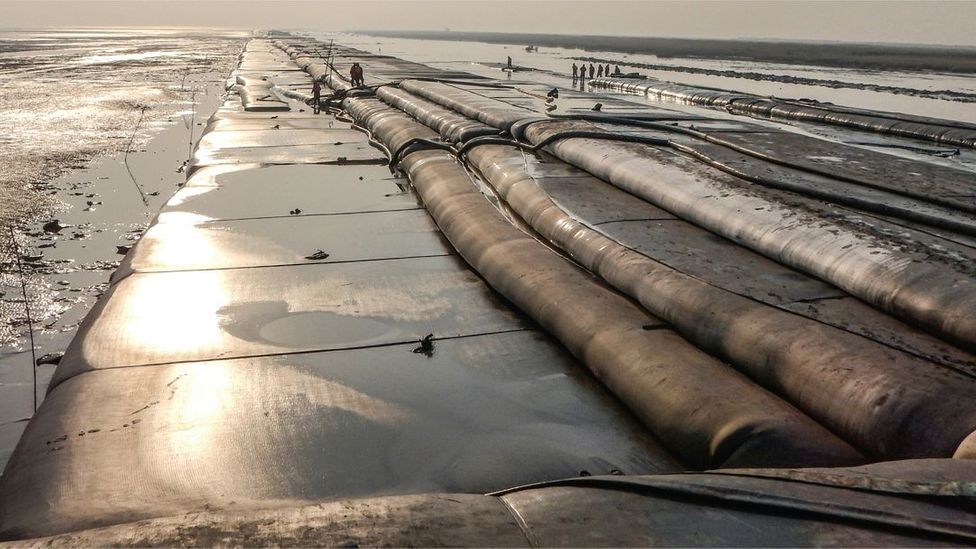
It’s one of the most impressive feats in modern engineering, and crossing the world’s longest sea bridge – the 55km (34 miles) Hong Kong-Zhuhai-Macau bridge, which opened in October 2018 at a cost of $20bn (£15.9bn) – certainly has its benefits. But impressive as it appears, this mammoth construction project, like so many others, has come at a cost.
No less than one million tonnes of concrete were used in the eight years it took to build the bridge. It was this concrete that invaded the habitat of the critically endangered pink dolphin, and is thought to be the reason that dead dolphins washed up on nearby shores while the population near the bridge plummeted by 60%. Of course, dolphins weren’t the only victims – habitats are destroyed and countless other marine species are affected when large amounts of concrete are poured into the ocean.
Destruction of this kind is often the cost of using concrete – the most widely used manmade material on Earth. With three tonnes per year used for every person in the world, there are few parts of the planet that concrete hasn’t reached. The production of concrete is also a huge emitter of CO2. At least 8% of humanity’s carbon footprint comes from the concrete industry, mostly from the production of cement – one of concrete’s principal components. The cement industry generates around 2.8 billion tonnes of CO2 per year – more than any country other than China or the US.
You might also like:
- The most powerful renewable energy
- The plane leading an electric revolution
- The strongest law on climate yet
In the oceans, concrete is the main construction material, accounting for more than 70% of coastal and marine infrastructure such as ports, coastal defence structures and waterfronts. In China, for example, around 60% of its coast is effectively concrete. Similarly, more than 14,000 miles of the US’s coastline is covered in concrete.
In China, around 60% of its coast is effectively concrete. Similarly, more than 14,000 miles of the US’s coastline is covered in concrete
“Concrete is damaging in the ocean because, to put it in place, natural ecosystems are destroyed,” says Alex Rogers, director of science at REV Ocean, a not-for-profit company studying ocean health and raising awareness of global impacts on the marine environment. “Concrete is a conventional material, everyone understands it, and it is low cost. But really, in this day and age, when we’re looking at much more sustainable ways of carrying out development – whether it’s coastal reclamation or other forms of building – we should be looking at alternative materials that have a lower impact on the environment.”
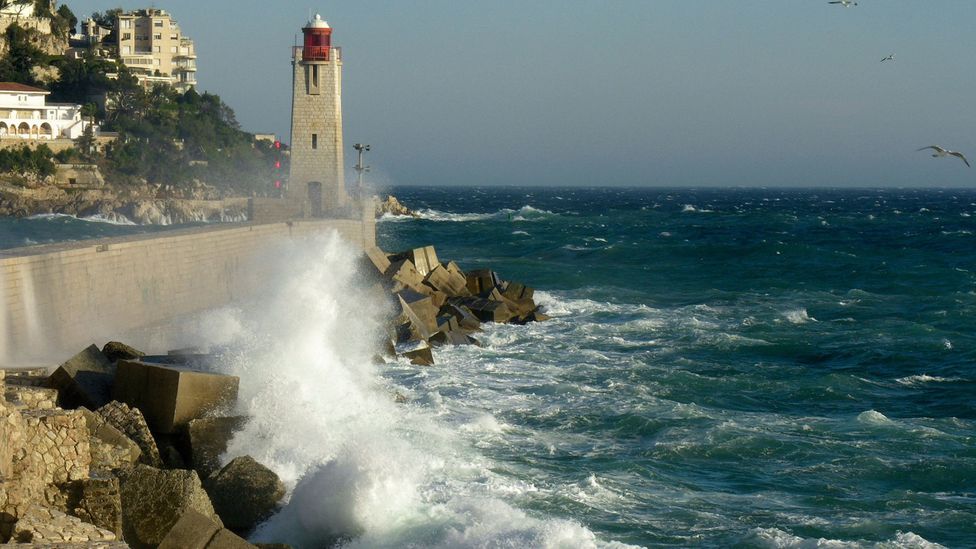
Concrete walls are an easy way to bolster the coastline from the sea, but the environmental impact of using this material is huge (Credit: BBC)
Those alternatives might already be here. Among them is a substance called ECOncrete, developed as an eco-friendly concrete. Co-founded by marine ecologist Shimrit Perkol-Finkel, ECOncrete produces bio-enhancing concrete products intended to protect and rejuvenate coastlines and marine resources. This is achieved by using a mixture made almost entirely of by-products and recycled materials, and is thus nearly carbon neutral. This mixture is combined with up to 70% slag cement (a by-product of the steel industry which has a low carbon footprint) and is beneficial for marine concrete thanks to its high chloride resistance. The overall result is a low-carbon concrete.
By retrofitting concrete surfaces with eco-tiles and panels that are designed with greater surface complexity, it gives room for marine life to colonise
But it is the nature of the concrete-water interface that makes the most immediate difference for local wildlife. Typically, the smooth concrete surfaces of artificial seawalls are not inhabitable for marine organisms. However, by retrofitting them with eco-tiles and panels that are designed with greater surface complexity – grooves, ridges and crevices – it gives room for marine life to colonise and hide from predators and harsh conditions, ultimately improving the biodiversity of the seawalls.
An example of where this appears to have worked is Hong Kong, where shortage of space has meant reclaiming land from the sea has been common for many years. In areas of reclaimed land in the city’s New Territories region, work is ongoing to retrofit four existing artificial concrete seawalls with different types of eco-engineered fixtures: seawall eco-tiles, eco-panels and “armour” units designed to protect tidal pools.
A preliminary test of eco-tiles in the western waters of Hong Kong found that the number of marine species had doubled to 12, compared with the number of species found on artificial seawalls without such fixtures. “The results were very positive, showing that the eco-tiles with enhanced complexity could significantly increase marine biodiversity,” says Kenneth Mei-Yee Leung, a professor of aquatic ecology and toxicology at Hong Kong University.
The bio-blocks are designed to mimic the intertidal zone – the area where the sea meets the land at high and low tides – in a bid to provide a more suitable habitat for marine species
Work is now underway to introduce Hong Kong’s first eco-shoreline. Part of a 130-hectare reclamation project in the city’s Tung Chung area to provide additional land for housing, the new eco-shoreline will use concrete bio-blocks designed to serve as shelter for marine animals such as crabs and molluscs, to recreate natural habitats lost to land reclamation. “As a marine ecologist, I hope the project will be a great success in promoting marine biodiversity,” says Leung, “while also providing a nice and multifunctional shoreline for people to enjoy and appreciate local marine life.”
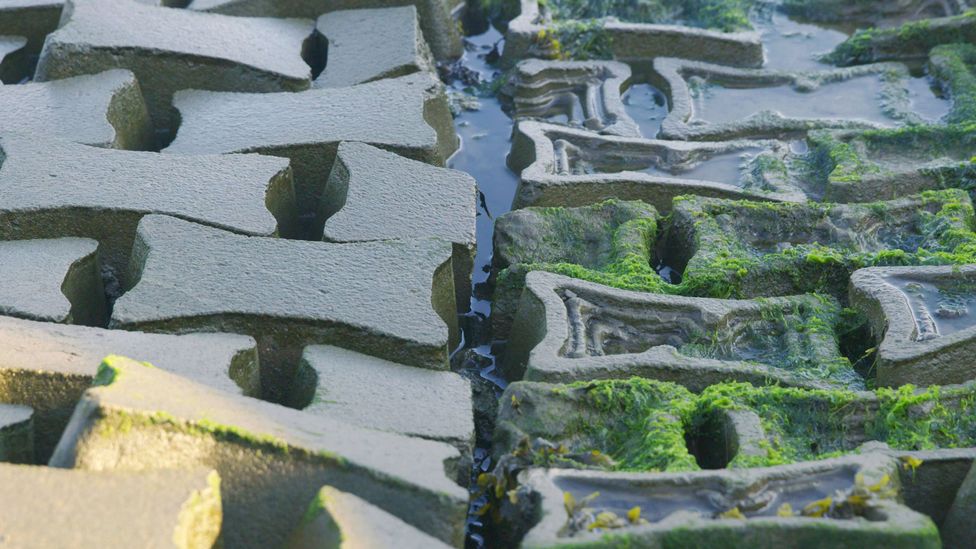
Wildlife-friendly blocks could reduce the harm to marine life by land reclamation (Credit: ECOncrete)
A 15-metre (49ft) installation has already been set up as a test site for the eco-shoreline that will eventually stretch 3.8km (2.4 miles), and is expected to be completed by 2023. The bio-blocks are designed to mimic the intertidal zone – the area where the sea meets the land at high and low tides – in a bid to provide a more suitable habitat for marine species.
Furthermore, unlike traditional concrete, which is highly alkaline, the specially designed concrete that is used for fabricating bio-blocks has a pH value (a measure of the acidity of substances) near to that of sea water, which helps to promote the growth of intertidal marine species such as crabs, molluscs, clams, mussels and oysters. The relatively neutral pH value of the bio-blocks is attained by replacing some of the ordinary Portland cement used in conventional concrete with alternative cementitious materials, such as slag cement, which has a secondary benefit of producing lower CO2 emissions.
“The seawater pH level is around 8, which is suitable to most marine organisms,” says Leung. “However, normal concrete has a pH of 12-13 which is not favourable to the colonisation of marine life. Therefore, concrete-based eco-engineered bio-blocks are commonly made with lower surface pH (pH 9 to 10) that are more suitable for marine organisms.”
ECOncrete’s products are already in use across eight countries and six different seas, from seawalls in Hong Kong to the Port of Rotterdam. “Our vision is that in the future, all man-made structures in coastal and marine environments will be designed and built with environmentally sensitive technologies,” says Perkol-Finkel.
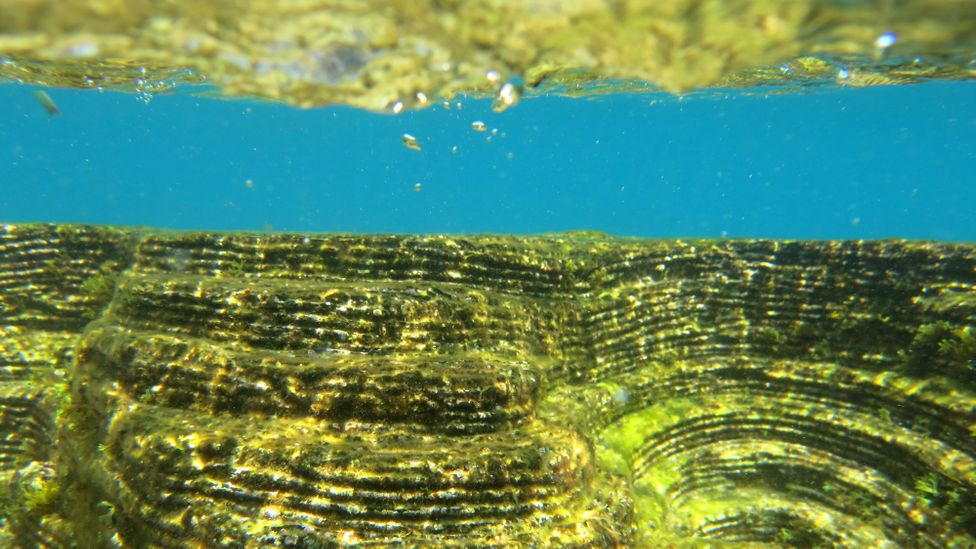
Adding ridges to concrete blocks is thought to help boost colonisation of marine life, but how effective it is depends on the nuances of the local environment (Credit: ECOncrete)
But not everyone is convinced that eco-friendly concrete bio-blocks are the solution.
Beth Strain, a lecturer in marine biology and a project leader for Australia’s National Centre for Coasts and Climate, says the evidence for eco-friendly concrete as a better surface for marine organisms is very mixed. “In some cases, authors have reported that these materials benefit corals or biofilms, whereas in other studies there have been no benefits for marine organisms.”
Strain says at the moment there is not enough proof of concept to really see where these eco-friendly concretes do and don’t work. “It can be location specific. We did an experiment in 15 harbours around there world with the same type of concrete surface complexity.” Largely, the results were positive, but there were some locations where it didn’t actually work. In Penang, Malaysia, for example, using concrete with a complex, creviced surface that would theoretically retain moisture and be better for organisms to latch onto made no difference. Strain thinks this is because of the area’s typhoons, which make the area very wet already, so the crevices of the concrete aren’t a big help. “There is a degree of difference and each location will have its own environmental challenges,” says Strain.
Nature-based solutions provide you with a solution that essentially self-repairs and keeps up with that sea level rise – Alex Rogers
Louise Firth, a lecturer in marine ecology at University of Plymouth, agrees that the results are mixed. “Those producing eco-concrete purport that lower pH in concrete is better for marine life,” she says. But in her recent research, currently under review, her team found that in Singapore and the UK, a lower pH didn’t make a difference to the colonisation of marine organisms.
But while eco-friendly concrete may require more testing, there are other potential solutions, such as bio-cement, which can be particularly useful for coastal hardening. Bio-cement is formed by taking sand, or other forms of aggregate, and then adding bacteria and urea, a component of urine. The urea triggers the bacteria to secrete calcite – a form of calcium carbonate – binding the mixture together into a solid material similar to limestone.
“Bio-cement is certainly a more interesting technology in terms of improving the sustainability of coastal defences and coastal hardening,” says Alex Rogers, the REV Ocean’s science director. “It has something like one-third of the CO2 production of normal concrete, and of course you can mould it to make it more biologically friendly.”
Not to be confused with bio-cement, is another alternative: bio-concrete. This is where bacteria called Bacillus pasteurii is actually encapsulated and added to the concrete, along with a form of starch that serves as its food. The bacteria stay dormant in the concrete until a crack forms and air gets in. This change wakes the bacteria up, and they begin to eat, grow and reproduce. In doing so, they excrete calcite, which bonds to the concrete, fills the crack and seals it up. So in essence, this type of concrete structure is capable of self-repair.
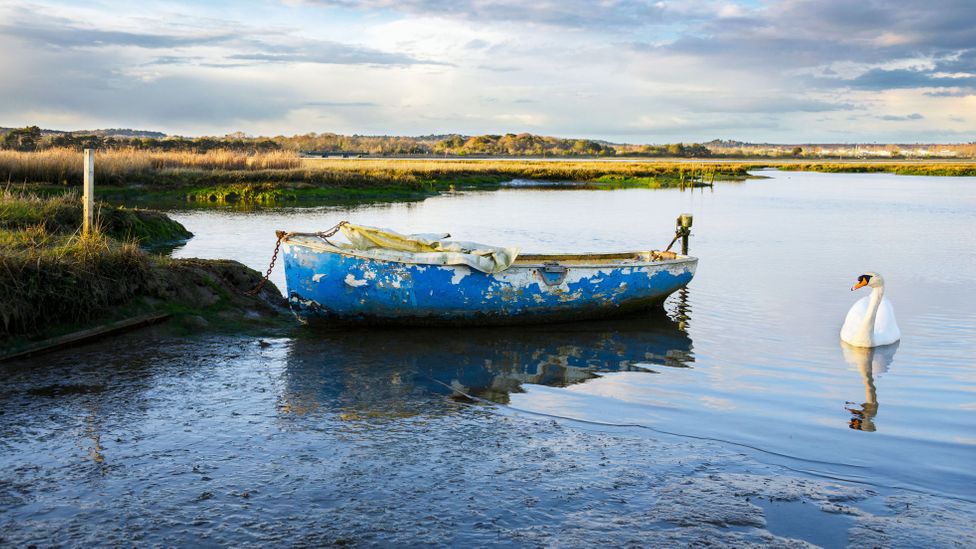
Natural habitats such as saltmarshes are an effective protection from the sea, and support a wide range of species (Credit: Alamy)
Then there are nature-based solutions for coastal defence as well – like seagrass meadows, coral reefs, mangrove forests, salt marshes and other forms of wetland. These types of habitat tend to increase in height naturally and they can also retreat further inland as sea level rises to provide constant protection. Going forward, nature-based coastal defences might be the best solution as hard concrete structures in the ocean are likely to encounter increasing problems as a result of climate change. Scientists say we’re going to see more than one metre of sea level rise within the next 80 years, causing traditional coastal defences to fail.
“Building hard concrete structures that don’t naturally adapt to increasing sea level could create an additional problem that periodically those defences will have to be built up or even replaced,” says Rogers. “Whereas nature-based solutions provide you with a solution that essentially self-repairs and keeps up with that sea level rise.”
In the UK, in extensive areas along the east coast, it’s now recognised that it’s not economically viable to continue defending the land using hard concrete structures because they only get broken up, undermined and destroyed as result of changes in the climate. Instead, there is a move towards favouring nature-based solutions, using some concrete where it’s essential.
One benefit of nature-based solutions is the huge biodiversity associated with them – in the UK these natural defences can be home to mussels, marine molluscs, fish, shellfish, salt-tolerant plants like glassworts, and seaweeds such as kelp. These areas are all also massive CO2 sinks, says Rogers. “Salt marshes have something like 40 times the CO2 absorption potential of tropical rainforests on a per area basis.”
From multiple perspectives, it appears that nature-based solutions are definitely the way forward. “Coastal engineers are going to have to change,” says Rogers. “They can’t economically afford to keep replacing concrete defences that are being undermined and destroyed by rising sea levels and increasingly extreme weather.”
Rogers believes that these engineers really need to take onboard the fact that nature can be used as a viable and long-term strategy for coastal defence and possibly even coastal reclamation.
Ultimately, of course, in an ideal world the best solution might be no reclamation. But until there’s a cost-effective alternative to concrete, or more widespread use of nature-based solutions, this material looks firmly set to stay.
--
The emissions from travel it took to report this story were 0kg CO2. The digital emissions from this story are an estimated 1.2g to 3.6g CO2 per page view. Find out more about how we calculated this figure here.
--
Join one million Future fans by liking us on Facebook, or follow us on Twitter or Instagram.
If you liked this story, sign up for the weekly bbc.com features newsletter, called “The Essential List”. A handpicked selection of stories from BBC Future, Culture, Worklife, and Travel, delivered to your inbox every Friday.
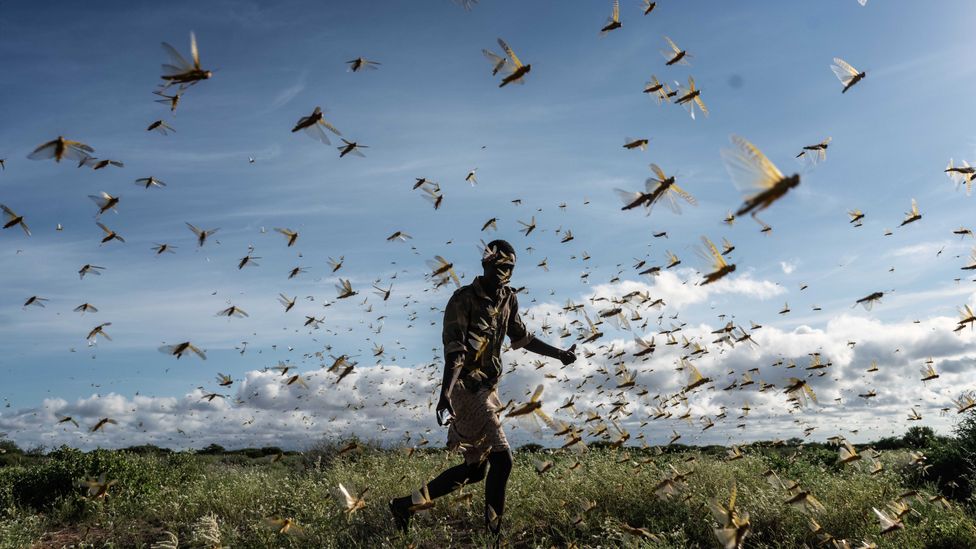
Drawn to an emaciated avocado drooping from a drying mother tree, Esther Ndavu wonders aloud if it will ever mature into the fist-sized oval fruit that keeps city residents going. Like many others at her farm in Mathyakani village in central-eastern Kenya, this avocado tree has been attacked by desert locusts. With a wide sweep of her right hand, Ndavu counts about 10 avocado, mango and paw paw trees that are losing their boughs after the infestation.
The locust invasion that swept over farms in rural Kenya from December 2019 has left farmers like Ndavu not only counting crop losses, but struggling with emerging environmental and health problems. The swarms have been the worst seen in Kenya for 70 years, and experts are concerned that swarms later in the year will be even larger.
Desert locusts, or Schistocerca gregaria, have often been called the world’s most devastating pest, and for good reason. Swarms form when locusts’ numbers increase and they become crowded. This causes a switch from a relatively harmless solitary phase, to a gregarious, sociable phase. In this phase, the insects are able to multiply 20-fold in three months and reach densities of 80 million per square kilometre. Each can consume 2g of vegetation every day – combined, a swarm of 80 million can consume food equivalent to that eaten by 35,000 people a day.
In 2020, locusts have swarmed in large numbers in dozens of countries, including Kenya, Ethiopia, Uganda, Somalia, Eritrea, India, Pakistan, Iran, Yemen, Oman and Saudi Arabia. When swarms affect several countries at once in very large numbers, it is known as a plague.
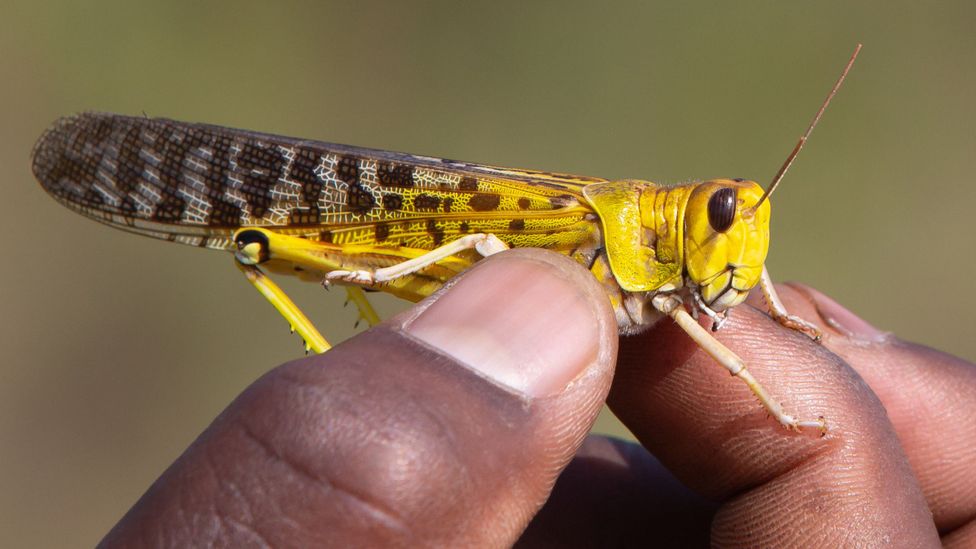
The gregarious desert locust is the world's most devastating migratory pest (Credit: Getty Images)
Ndavu’s village of Mathyakani, which covers about 50 sq km (19 sq miles), is home to about 10,000 people. At Ndavu’s 1.6 hectares (four acres) of land, the locust swarms destroyed produce worth 50,000 Kenyan shillings ($460/£350), which she was set to begin harvesting in July.
You might also like:
- The destructive power of extreme hail
- The ingenious ‘solar canals’ of India
- The revolutionary boat powered by the ocean
The vegetation that grows at the edges of her farm, where she used to collect fodder for her livestock, was also depleted by locusts. With nothing to feed her livestock, she has moved them to a neighbouring village which was spared the invasion. There, she pays about 100 Kenyan shillings (93 cents/70p) every day to her hosts for her cattle to feed. The manure produced by her six cows remains with the hosts as additional payment.
This locust invasion is more than a challenge. It is a matter of life and death – Esther Ndavu
“I have gone through a lot of challenges growing up as an orphan,” says Ndavu. “But this locust invasion is more than a challenge. It is a matter of life and death because it has left us hungry and confused.”
The toll of defence
In February 2020, local media reported that a swarm covering 2,400 sq km (930 sq miles) was recorded in northern Kenya and could have been the largest on record in Kenya. At Ndavu’s village, the locusts occupied about 20 sq km (7.7 sq miles) of vegetation when they swarmed.
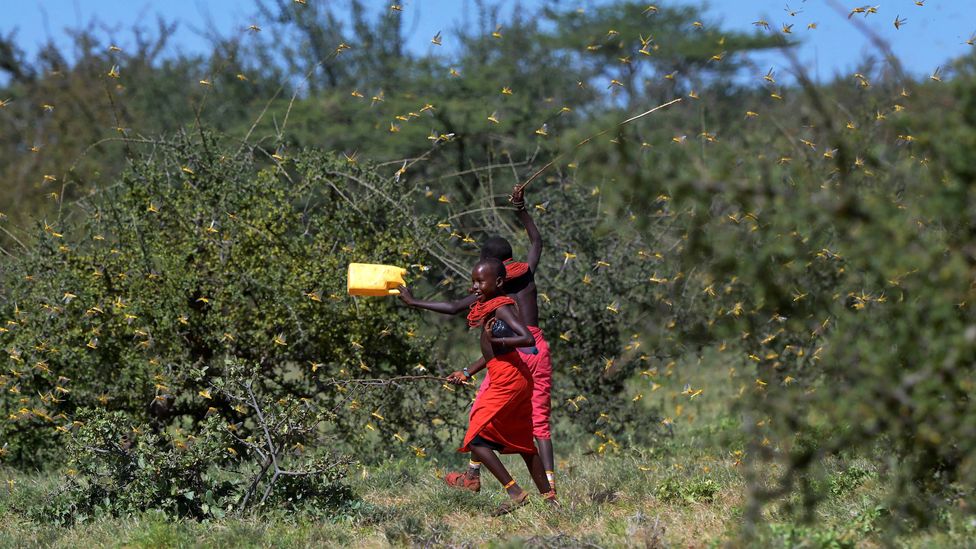
The effort of trying to scare locusts away by shouting has taken its toll on both children and adults in affected villages (Credit: Getty Images)
The invasion has taken its toll on mental health in the village of Mathyakani. For more than a week during the infestation, Ndavu’s children could not go to school. They stayed home to help their parents battle the swarm that had landed on their farm.
At first adults used the tools immediately available to drum away the locusts as well as lighting fires and burning vehicle tires, says Ndavu. Children were enlisted to scream at the pests to try to scare them away before the village was able to use pesticides. That drumming and screaming has left a lasting effect on her children.
“Most nights I do not sleep enough,” says Ndavu. “The children wake me up when they begin screaming at night. When I ask them what the problem is, they tell me that they were dreaming that another locust invasion had come to our home.”
Peninah Nguli, a teacher from a village neighbouring Mathyakani, adds women have been particularly affected. Women are typically responsible for crop farming in the region, while men look after livestock. Some women are suffering from throat problems due to the strain of shouting to scare away the insects, says Nguli, while most fear another swarm.
Another swarm is indeed likely, and it could be devastating. Another surge would put between five million and 25 million people at risk of acute food shortage in East Africa. A further 25 million people will face acute food insecurity.
Tools for resilience
In mid-February, Kenya’s government announced it was focusing its intervention measures in areas heavily infested with locusts in the north. The interventions included manual and aerial spraying of pesticides, followed by deployment of response teams to assess the damage caused by the locusts. That assessment would then help the government come up with a plan on how it would support livelihoods of Kenyans affected by the locust invasions.

Esther Ndavu inspects her crops. Some of those that escaped the locusts have developed disease (Credit: David Njagi)
Kenya was one of nine beneficiaries of a $1.5m (£1.1m) grant given to the Intergovernmental Authority on Development in April by the African Development Bank to help the East and Horn of Africa battle the locust invasions. In May, the World Bank distributed a further £43m grant to aid 70,000 pastoral households and 20,000 farmers in Kenya to recover from locusts.
One way this funding could be used to help farmers like Ndavu is equipping them with technology so that they can battle new locust infestations, says Moses Muli, a social and conservation expert who has worked with Action Aid, Kenya, for six years.
The first line of defence is chemical insecticides, which can be distributed using packs on the ground, or by aircraft. During Covid-19, this protection has been made difficult or, in some places, impossible because of disruption to the chemical supply chain. And spraying, though one of the more effective methods, comes with drawbacks: the substances used can be harmful to the environment and to human health.
Alternatives include the use of drones and electrified metal grids to control locust swarms. Drones can be navigated to fly low enough to spray chemicals and do surveillance, without the need for larger planes with human pilots. Electric grids can be dragged over fields to generate vibrations in open fields to scare away the locusts and shock any that it comes into contact with. While early tests of the grids have been successful, they may be better suited to smaller swarms.
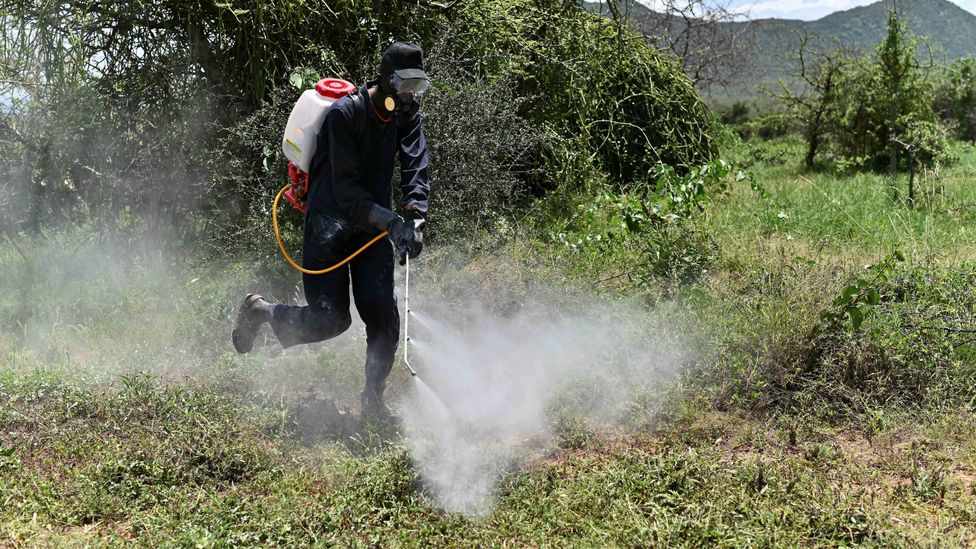
Spraying fields with pesticides can be an effective way to kill locusts, but getting chemical supplies in 2020 has been difficult due to Covid-19 (Credit: Getty Images)
Another option is to use “biological pesticides”, based on the fungus Metarhizium acridum that infects and kills locusts. Fungus-based pesticides are thought to be harmful to a much narrower range of species than conventional pesticides, and so pose less risk to the environment and people. However, some researchers have questioned whether fungal deterrents could also harm other species of insect, such as termites. They also take longer to kill the pests than conventional pesticides, which risks greater crop damage.
But some of the key protection comes before the swarm arrives. Remote weather alert stations within farms could also help farmers prepare for future locust invasions. Locust swarms usually happen when a prolonged drought is followed by heavy rains, says Muli. Remote weather stations could help to capture data that reveals such weather variations and gives farmers time to start spraying early.
For Munyithya Kimwele, a farmer in Mathyakani, investing in forecasting is the best option for families to be prepared for future locust swarms. “Long ago traditional forecasts would help villages prepare for locust invasions. This is the best intervention the government can give to poor farmers like us,” says Kimwele.
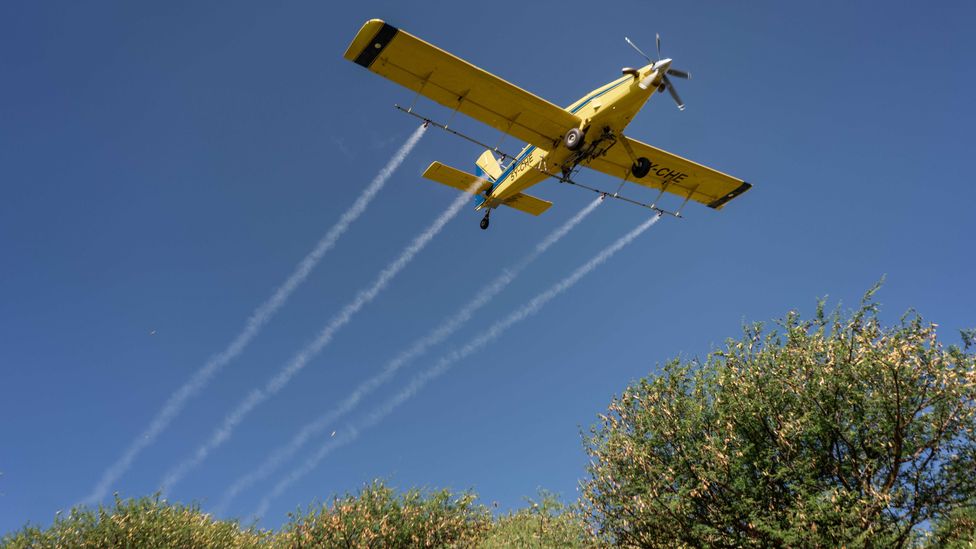
Kenya's efforts in tackling locusts have been focused in the north of the country, including flyovers by pesticide-spraying planes (Credit: Getty Images)
In villages like Mathyakani, which has not been a priority area for spraying or government assistance, farmers are taking steps towards recovery by diversifying their crops. Instead of relying on traditional crops like maize and cowpeas, which are more vulnerable to locusts, a growing number of farmers are investing in fruit and vegetables.
The locusts are not likely to go away soon. This is because of erratic weather, which has led to prolonged rains is providing the pests with enough vegetation to keep them fed and breeding – Ezra Kipruto Yego
This has been made possible by village irrigation projects that Action Aid Kenya, in partnership with some farmers, established there in 2009. About 40 families along the seasonal river Enzio enlisted with the project, which helps them grow cabbages, tomatoes, kale and capsicum, among other crops by sinking a series of boreholes along the river. This group is not as worse off after the locusts as farmers who had only grown maize, green grams and cowpeas, says Nguli.
“Hungry families from neighbouring villages come to us for help and we give them food,” says Nguli. “We also train them on how to take advantage of the irrigation project and establish kitchen gardens to guard them against future food shocks.”
Predicting plagues
The question of whether the Horn of Africa could experience worse plagues of locusts in future is a difficult one to answer, according to Ezra Kipruto Yego, the Sustainable Development Goal coordinator of the UN Sustainable Development Solutions Network.
Yego sees a possible link between climate change, extreme weather events and locust swarms in East Africa. For example, when last year’s cyclones in the Indian Ocean made landfall, they may have created an attractive environment for locusts to swarm into the region from their nesting sites in the Middle East, he says.
“The locusts are not likely to go away soon. This is because of erratic weather, which has led to prolonged rains is providing the pests with enough vegetation to keep them fed and breeding,” says Yego.
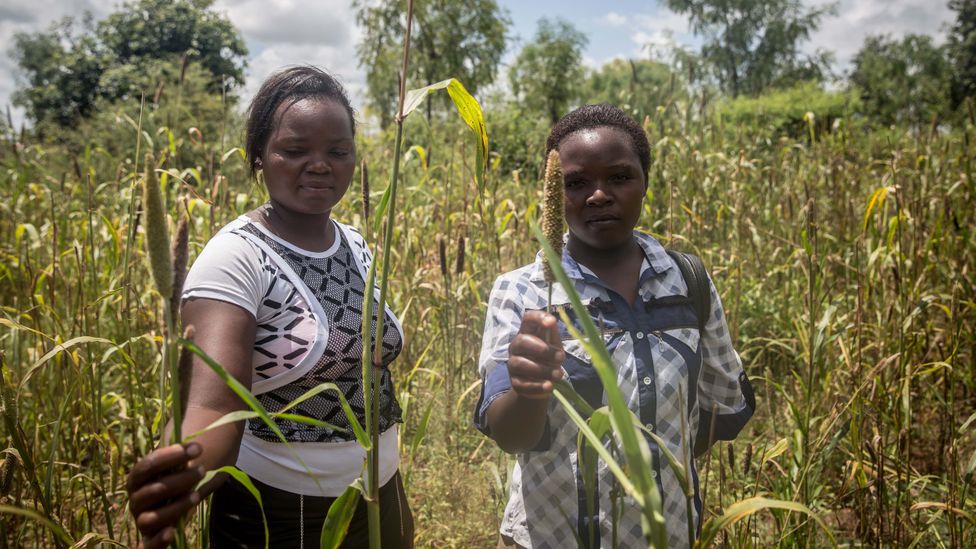
Farmers across East Africa have had crops devastated by the desert locust, with millions facing acute food shortage in the second half of the year (Credit: Getty Images)
Another major challenge for controlling locusts in east Africa is political instability. For instance, Yego says, UN agencies that have committed to fight the swarms rarely risk taking their personnel to countries like Somalia, which experiences frequent attacks from al-Shabab militants.
Hence, when a country like Kenya makes headway in containing locusts, those that have bred and hatched in less politically stable countries often swarm across borders. That makes international peacebuilding and political stability a key part of dealing with locusts, says Yego.
Until such large-scale international solutions are possible, the people of Mathyakani are working hard to adopt and build post-locust resilience, says Ndavu. But all the while there is the threat of another swarm. The locusts of the most recent invasions laid eggs in the area, which could hatch later in the year close to harvest time.
People have lately seen locust hatchlings hopping around the village. They spray them with pesticides, and sometimes they die and disappear.
“I know this is not over yet,” Ndavu says.
--
The emissions from travel it took to report this story were 46kg CO2, travelling by bus, car and motorbike. The digital emissions from this story are an estimated 1.2g to 3.6g CO2 per page view. Find out more about how we calculated this figure here.
--
Join one million Future fans by liking us on Facebook, or follow us on Twitter or Instagram.
If you liked this story, sign up for the weekly bbc.com features newsletter, called “The Essential List”. A handpicked selection of stories from BBC Future, Culture, Worklife, and Travel, delivered to your inbox every Friday.
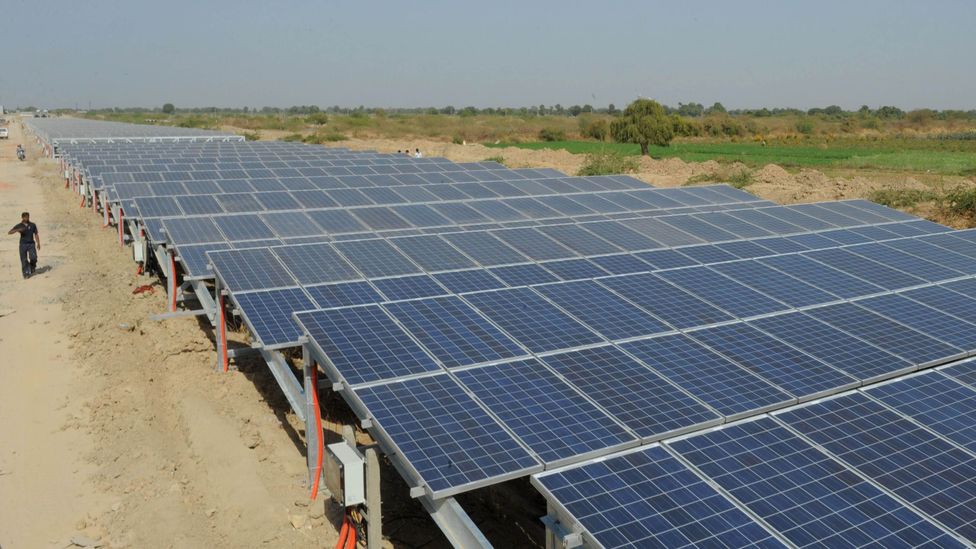
As the harsh midday sun beats down on a small, dusty village in Gujarat, western India, lines of blue solar panels on steel support structures snake their way to the horizon. The panels cover the top of irrigation canals, gleaming like iridescent mirrors. This small village of 40 homes with thatched walls and tin roofs, and lumbering stray cows, was one of rural India’s many communities who, until recently, did not have electricity. But now a lamp lights each home so children can study at night, and farmers can milk their cows long after sunset.
India has relied traditionally on coal-fired power plants, which generated 72% of the country’s electricity in 2018-19. India’s combination of abundant sunshine – about 300 sunny days in a year – and a large energy-hungry population makes it an ideal location for solar. The country’s solar capacity reached 36.6GW at the end of the first quarter of 2020, with the aim of growing to 100GW by 2022.
But one of the main challenges in building solar farms is finding the right place to do it. Land is relatively expensive in India and often has multiple owners, so the purchase of land involves many formalities. India’s high population density also puts pressure on the land, with an average of 464 people per square kilometre. Rooftop solar panels are one solution, but sunny space atop buildings is limited too.
In Gujarat, the answer has been to cover its canals with solar panels, as a solution that saves land, water and carbon emissions in one.
You might also like:
- The divers rescuing a drowning island
- Inside India’s humungous solar plant
- The most powerful renewable energy
In the last few years, the solar energy market's focus has shifted from large-scale utility projects, to smaller projects that make more innovative use of space, says Payal Saxena, manager of strategy consulting at Gensol Engineering, and canal-top solar is a prime example.
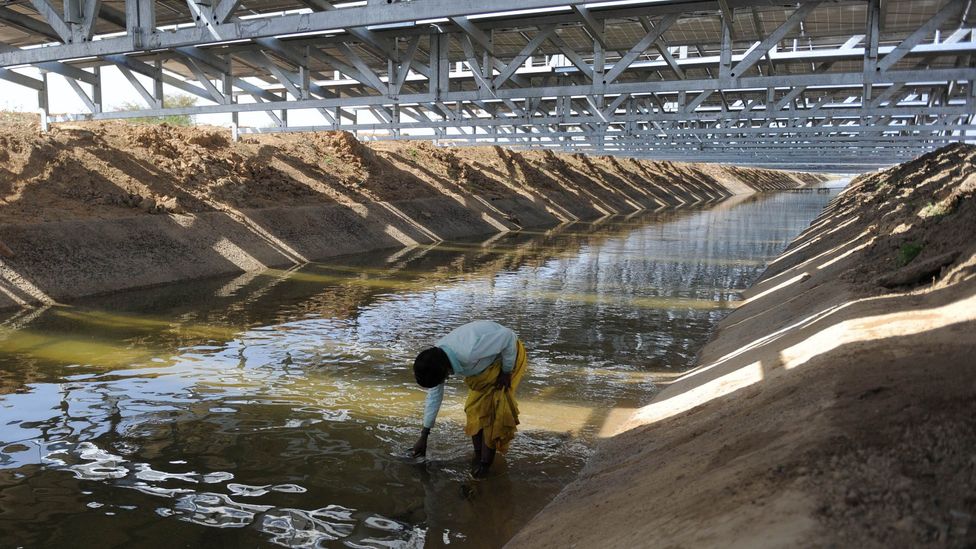
The solar canals are suspended on a metal structure over the canal, with benefits for both water conservation below and cooling of the panels above (Credit: Getty Images)
A pilot 750m stretch in Gujarat in 2014 led to the first large-scale canal-top solar power plant in the Vadodara district of Gujarat in 2015, at a cost of $18.3 million. The long stretch of the canals leading off the Narmada River enables electricity to be extracted at multiple points, says Manik Jolly, chief executive of Grassroots and Rural Innovative Development, who was involved in the first Narmada River canal project.
The energy generated from the solar canal can provide electricity for farmers during the energy-intensive irrigation season, and out of season the electricity can be fed into the state grid, sold to distribution companies or used by the canal authority, says Jolly. Since this power is generated in a rural area, the transmission losses are reduced and the local grid is strengthened.
Since the first solar canal project, a number of others have been commissioned in India, including a 100MW canal-top solar power project atop the branch canals off the Narmada River, stretching for a distance of 40km, at an estimated cost of 1bn Indian rupees ($13.9m/£9.3m).
Overall, Gujarat has more than 80,000km of canals meandering through the state. According to Gujarat State Electricity Corporation, if 30% of this were converted to solar, 18,000MW of power could be produced, saving 90,000 acres of land.
Mutual benefit
The advantages of solar plants atop canals are not just about local energy production and land saved. For one thing, solar power plants can be built much faster than large coal or gas power stations. For another, the covering over the canal helps to prevent evaporation of water, leaving more available for crops and people.

India experiences water stress in many areas, including Gujarat, where canals are known to dry up due to a warming climate and management difficulties (Credit: Getty Images)
In states like Gujarat, Rajasthan and Maharashtra, where canals are mainly used for irrigation, evaporation is a big problem, notes Pulkit Dhingra, founding director of Ahmedabad-based AHA Solar Photovoltaics.
Another plus of the panels’ shade is curbing algal blooms in the canals. Algae growth can clog water pumps and cause toxicity. “With the installation of the solar panels, and absence of direct sunlight, algae growth is drastically minimised,” says Nilesh Kumar, senior project officer at the Gujarat Energy Research and Management Institute.
And while the water can benefit from the solar panels above, so do the panels from the water below. The running water helps the panels to remain cool, which increases their efficiency by at least 2.5-5%. There are some drawbacks, however. Canal-top plants are more expensive to construct than normal solar plants. The supports have to be galvanised with a protective zinc layer because the water below increases the risk of corrosion. Finding the right location is difficult too, as the width of the canal has to be just right, says Dhingra. Too wide, and the construction becomes difficult and expensive. Too narrow, and the number of panels that can be constructed are too few to absorb enough sunshine. And of course there has to be sufficient stretch of canal to accommodate the planned solar structure.
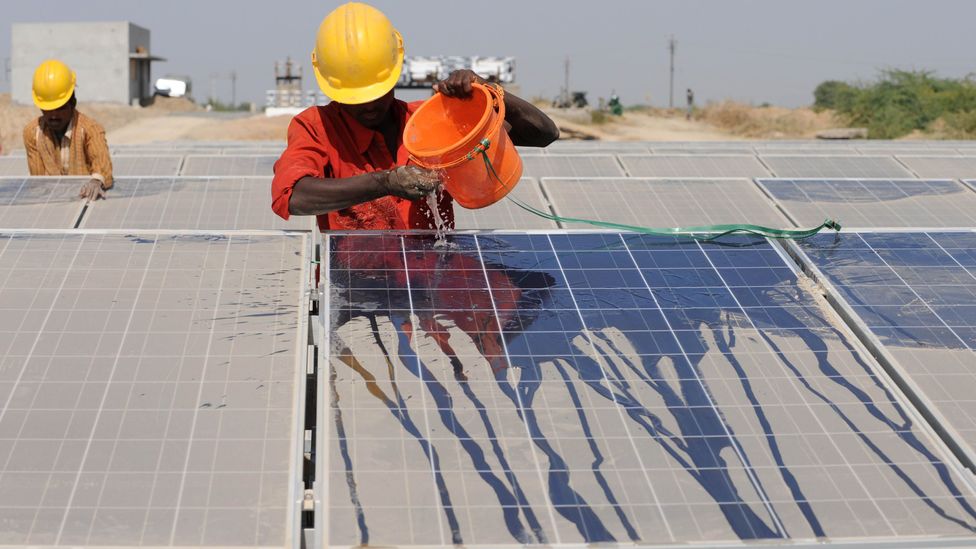
Like conventional solar panels, those above canals also require frequent washing to ensure their capacity isn't reduced by dust (Credit: Getty Images)
And, like solar panels placed on land or rooftops, the panels must be cleaned regularly as electricity production declines if dust collects on top of them. The operation and maintenance of canal-top projects is a big challenge, as ramps have to be built to enable cleaning, says Jolly. Some companies use sprayers and robots to clean the panels in remote areas. “Because canal-top plants are spread over large areas and cannot be protected by boundary walls or fencing, security concerns are major – cameras may have to be installed to monitor pilferage,” adds Gensol Engineering’s Payal Saxena.
The meandering nature of the canals also imposes restrictions. To maximise the absorption of energy, the solar panels should face south, but the canal’s direction cannot be dictated. Solar panels also act as an obstruction to repair the canals or remove silt, and very often trees along the canal have to be cut down as the areas have to be shadow-free.
So far, eight Indian states have commissioned canal solar projects. “These innovative projects can provide cheap and consistent electricity to millions of farmers and improve their profits,” says Jolly. And there is more potential to maximise renewable power from India’s canals, if solar farms above were combined with hydro-power from below, as researchers such as Sabah Usmani, an analyst at the Environmental Defense Fund, have suggested.
With their water-cooled efficiency, and mutual benefits for the canals that run beneath, it looks likely that these snaking, glittering solar canals will become a much more common sight in India.
--
The emissions from travel it took to report this story were 0kg CO2. The digital emissions from this story are an estimated 1.2g to 3.6g CO2 per page view. Find out more about how we calculated this figure here.
--
Join one million Future fans by liking us on Facebook, or follow us on Twitter or Instagram.
If you liked this story, sign up for the weekly bbc.com features newsletter, called “The Essential List”. A handpicked selection of stories from BBC Future, Culture, Worklife, and Travel, delivered to your inbox every Friday.
No comments:
Post a Comment